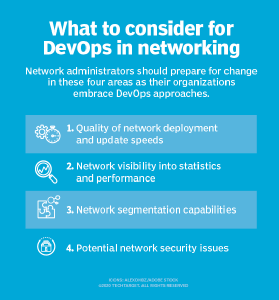
Fotolia
How does DevOps in networking change network requirements?
As more organizations embrace DevOps in networking, the approach can transform network requirements, such as visibility and security policies, which network teams should consider.
DevOps, continuous integration/continuous delivery or Agile teams have different network requirements than any other department. All three of these teams aim to eliminate roadblocks that slow down software development innovations. Thus, the speed of network deployments and changes is crucial to these development methodologies' overall success.
While network and application speeds constitute one area where DevOps in networking shifts requirements for network administrators, other areas where DevOps sparks change include network visibility and security requirements.
Four considerations for DevOps in networking
Below are four key areas of change network admins must consider for DevOps in networking.
Deployment and update speeds. To ensure quality deployment and update speeds, network admins can provide DevOps teams with self-service network deployment and customization portals to speed up deployment and update processes. This can also reduce the need for network admins to manually make changes on the DevOps team's behalf.
Network visibility. DevOps teams require more visibility into their development or test networks compared to other teams. When DevOps teams test application performance, they need access to network performance statistics to determine whether an issue relates to the network versus an application.

Network admins can provide DevOps teams access to network monitoring and performance tools, which will help with visibility. Additionally, network admins can create customized reports that DevOps teams can run as needed.
Network segmentation capabilities. A DevOps team will require a segmented network for testing purposes. This network should operate as close to production as possible. That way, a DevOps team can be reasonably sure an application will perform the same on a development or test network as it does when it migrates into the production network.
Network security. Network admins must take appropriate security measures when they segment development or test networks from production. These networks often require access to outside resources, such as DNS, Dynamic Host Configuration Protocol and Network Time Protocol. Development networks require access control or firewall rules to enable access solely to specific external resources and prevent all other outside access.
More recently, IT teams have built development networks within public or private cloud environments, as opposed to within the corporate network. Thus, teams must duplicate the same network security policies found on the LAN and push those policies out to cloud networks.
While teams can accomplish this policy push manually, a better approach is to use software-defined networking (SDN) or intent-based architectures that centralize and push out network and network security policies to on-premises and cloud network equipment. Alternatively, teams can seek out tools that offer the same centralized configuration capabilities of SDN or intent-based networks on more traditional, distributed intelligence networks.








